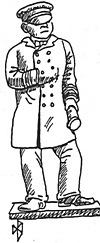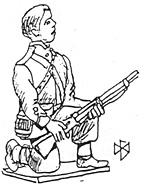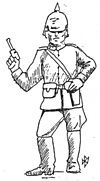 C. S. Forester's remarkable short novel "Brown on Resolution" was first published in 1929, barely fifteen years after the events, which led to the loss of Craddock's Cruisers at Coronel and the crushing retribution of the Royal Navy's Battlecruisers at the Falklands. Those who read the novel then knew of the events, which formed its background, and the book achieved phenomenal sales, and is still in print, in paperback, today.
C. S. Forester's remarkable short novel "Brown on Resolution" was first published in 1929, barely fifteen years after the events, which led to the loss of Craddock's Cruisers at Coronel and the crushing retribution of the Royal Navy's Battlecruisers at the Falklands. Those who read the novel then knew of the events, which formed its background, and the book achieved phenomenal sales, and is still in print, in paperback, today.
The first half of the book tells of the early life of Leading Seaman Albert Brown, and may be of little interest to the modem wargames oriented reader. The book begins in earnest at Chapter 10, with the outbreak of war. HMS Charybdis a very elderly cruiser, is at Singapore when orders come to search for Von Spee's Squadron or hunt the two ships, which had detached themselves from his force to wreak havoc in the sea-lanes. SMS Emden's career is well recorded elsewhere, but Forester chooses to tell us the tale of the 3-funneled armoured cruiser SMS Zeithen and her encounters with the Royal Navy and one of its most resolute seamen.
Kapitan von Lutz, aboard the Zeithen had ten 5. 9" guns with which to pound any enemy light cruiser into submission, and the speed to escape any larger man 0' war. A thousand miles from the South American coast, the German ship encountered the 'pursuing' Charybdis. One of the oldest 4,000 ton Royal Navy cruisers armed only with four 4. 7" guns stood no chance at all, her radio transmissions jammed by the German cruiser, Charybdis sank leaving only three survivors, two badly wounded men and Albert Brown, RN.
Although the sea battle had been almost completely one-sided, one of Charybdis' 4. 7"s had scored a hit on the armoured cruisers hull, just forward of the belt and a foot above water.
SMS Zeithen needed repairs before she could face the gales and rollers of Cape Horn, a neutral port would mean internment and the announcement to the world of her presence, and she was 5,000 miles from a safe friendly harbour, with the Japanese fleet between. Von Lutz decided, since his own artificers could repair the damaged plates in a calm anchorage, to head for the Galapagos Islands. Resolution Island in fact 'the most northerly of the Archipelago' and the most remote. As she steamed towards the chosen refuge, Brown now fully recovered was set to help nurse his two shipmates. Why not? Escape was impossible, and what could one British seaman, unarmed achieve aboard a ship of 300 men?
Resolution, lonely and rarely visited is described by Forester as an extinct volcano crater, through which the Pacific has broken on one side, leaving a ring of towering cliffs around a lagoon half a mile wide, with 20 fathoms at her entrance and unknown depths within. The rings of cliffs is nowhere more than a few hundred yards wide, and are of huge lava rocks as sharp as knives, while the lower slopes are covered in sharp thorn cactus and the whole bowl is like an oven in the hot sun.
Zeithen slips in quietly and is carefully anchored with her bunkers cleared on the starboard side and even her battery moved to expose her plates a foot or two more for the artificers work.
Brown examines Resolution Island through the sick bay porthole, and realises that the cruiser could be disposed of in her present situation by even a 12pdr Quick Firer!
 A plan forms in his mind.
A plan forms in his mind.
If he could delay the repairs for a while or even drive the ship away unrepaired, then the Royal Navy with her cruisers scouring the seas would find Zeithen soon and dispose of the threat.
Outside the sick bay stood an arms rack for a boarding party, just as on every cruiser. Brown rearranges two sets to give himself two waterbottles, two full days emergency rations and 120 rounds of ammunition for the Mauser Gewehr 1898 rifle, which he intended to use to stop Zeithen's repairs. The 7. 92mm bolt action Mauser weighing 4.2kg and with a muzzle velocity of 640m per second was not as good a rifle as the Lee-Enfield on which Brown had practised his musketry, but sound enough for his purpose, and easy enough for a skilled marksman to adapt to. Brown leaves the ship burdened with his gear tied to a lifebelt, and swims to the shore.
The sharp thorns and hard lava wound him badly but with great effort the seaman heaves himself onto a secure ledge and waits for dawn. It's the day of the Battle of Coronel, the ship's radio picks up the news and von Lutz is keen to be out at sea again, only 12 hours work to repair the hull and he could follow Von Spee into the Atlantic.
Brown is noted as missing, but what harm could he do?
Plenty. Lying on a lava shelf less than a quarter of a mile away from Zeithen with a full magazine, Brown watches the day begin aboard the cruiser. Bosun's chairs are let down over the side to the hole and as the Maschinistsmaat sets to his work, Brown picks him neatly off the chair, and follows by killing the second artificer. As groups of men gathered at the side Brown kills several more Germans.
The deck clears.
Brown's Mauser commands the whole of the starboard side and stem of the ship; von Lutz clears away the ship's steam pinnace and a landing patty. Brown kills the helmsman with his first shot, and the pinnace pulls to shore under a rock. The twenty men in the landing party swarm ashore less than 100 yards from Brown, but lined up for a 'rush' at the hidden enemy they are blocked and injured by the cacti and lava. All the while, Brown uses them as target practice. Six shots = six dead sailors. The remnant of the group take to cover as best they can, and fire at whatever draws their attention, but not at Brown. No one can spot his position.
The lieutenant commanding the party is killed and the men creep back towards the water's edge and the safety of the pinnace. Those wounded by Brown die in the hot sun, while their comrades are unable to help them. Aboard Zeithen von Lutz gives orders for a further work party to repair the ship's plates, Brown has already delayed him by six hours.
The pinnace returns to the ship and one of the unwounded but torn and cut sailors is interrogated by the Kapitan. The others are all dead, so is the lieutenant, and the one man opposing them is hidden somewhere up the cliff.
 Brown Waits
Brown Waits
The largest landing party the cruiser can assemble is sent ashore, some two hundred armed men. Not one more can be spared, as booms for screens to hide the work from the rifleman are hurriedly made and hung over the side.
With Teutonic precision, the men all carry food and water, sufficient ammunition for the work and are told off into parties to beat through different sections of the impossible terrain. Von Lutz places riflemen on the tops of the ship and machine guns too, which rake the island pointlessly to suppress Brown's fire as the big landing party is ferried in by the pinnace. Brown could not move in daylight, and far from his place the first small group began to move towards him. The line broke up in disarray over the harsh ground, and night fell. During the dark hours the Germans exchanged shots with each other, and Albert Brown clambered down to the sea, and with his lifebelts paddled along the lagoon to a new position.
Exhausted and as injured as most of the Germans ashore, Brown finds a new spot, almost a cave. Protected from above it gives him the chance to shoot at the hull work again. Brown knows not to fire at night and give away his position to marksmen and machine guns.
As dawn breaks the Germans are scattered in odd bunches all over Resolution, but none within a hundred yards of Brown, whose new post enables him to kill more artificers as they work on the plates.
By late afternoon the delayed work is completed, and the only task left is to kill the single British enemy before the ship sails. They can hear the rifle shots echo from the cliffs but have no idea where he is. Another fifty sailors are landed to pursue Brown, who is exhausted by lack of water and has only twenty rounds left.
Another night is passed with wild firing and futile attempts to move around the island hunting the sailor down. In the morning the Germans are even more dispersed, some on the crest of the ridge of the island some along the shore. One group is very close to Brown, and will find him soon, he thinks. The ship's siren sounds, and flags flutter the general recall.
Ashore the officers blow their whistles and the men begin to evacuate Resolution Island. They can move only slowly, and by noon less than half are at the water's edge, and Brown has wounded the ship's Second-in Command.
Most of the rest of the day is spent in gathering together the men from all corners of the cliffs and shore. As night falls a lucky shot wounds Brown, who will die from this eventually. Another night is passed by fifty Germans huddled in little groups, firing occasionally into the darkness. Next morning by noon, with Brown faint from the loss of blood, all of the Germans who are going to get back to the ship have arrived aboard her.
SMS Zeithen weakened by the loss of seventy men dead and wounded sails out of the lagoon with Brown watching her. He dies thinking he's failed but his two day delay imposed on the cruiser has delivered the Kaiser's ship into the hands of a Royal Navy Battlecruiser, HMS Leopard which accompanied by the Light Cruiser Yarmouth has passed the Panama Canal and is heading for the Galapagos Archipelago at speed.
This was the news, which demanded von Lutz sound the general recall of his men with Brown untaken.
The battle is as one-sided as that which sank Charybdis , the armoured cruiser is no match for the 12" gunned Battlecruiser and her consort. Von Lutz' ship explodes and sinks with all hands.
Ship Notes
You will search the navy lists in vain for SMS Zeithen, the only ship of that name in the Imperial Navy was a Torpedo Cruiser in the 1870's. Nor will you find HMS Leopard to be a Battlecruiser, though the name's an obvious choice, she was a 30 knot torpedo boat which served in WWI, and the only Penzance was a Sloop lost to a V-Boat in 1940. Charybdis however, was a little old cruiser built c1893, and she survived on auxiliary duties in WWI without fortunately meeting a German armoured cruiser.
Nor will you find Resolution Island on the charts of the Galapagos Archipelago, though Darwin's Bay is rather similar; Resolution is much more like Deception Island in the Antarctic Ocean, and indeed Forester describes his island as 'unknown' in the preface.
Back to Table of Contents -- Lone Warrior # 146
Back to Lone Warrior List of Issues
Back to MagWeb Magazine List
© Copyright 2004 by Solo Wargamers Association.
This article appears in MagWeb.com (Magazine Web) on the Internet World Wide Web.
Other articles from military history and related magazines are available at http://www.magweb.com
